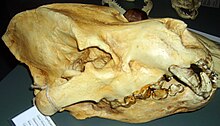Percrocutidae
| Percrocutidae Temporal range: Middle Miocene to Late Pliocene | |
|---|---|
 | |
| Dinocrocuta gigantea skull cast, Zoological Museum in Copenhagen | |
| Scientific classification | |
| Domain: | Eukaryota |
| Kingdom: | Animalia |
| Phylum: | Chordata |
| Class: | Mammalia |
| Order: | Carnivora |
| Suborder: | Feliformia |
| Superfamily: | Herpestoidea |
| Family: | †Percrocutidae Werdelin & Solounias, 1991 |
| Genera | |
Percrocutidae is an extinct family of hyena-like feliform carnivores endemic to Asia, Africa, and Southern Europe from the Middle Miocene through the Pliocene, existing for about 8 million years.[1]
The first percrocutids are known from the middle Miocene of Europe and western Asia and belonged to the genus Percrocuta. Percrocuta already had large premolars, but did not carry such a massive bite as the later form Dinocrocuta, from the later Miocene.[2] Originally, these carnivores were placed with the hyenas in the family Hyaenidae. As of 2013[update], most scientists considered the Percrocutidae to be a distinct family - although usually as sister-taxa/immediate outgroup to Hyaenidae.[3] Sometimes it was placed with the family Stenoplesictidae into the superfamily Stenoplesictoidea. However, studies in the 2020s placed Dinocrocuta and Percrocuta as true hyaenids, invalidating the family Percrocutidae.[4]
Taxonomy & Evolution[edit]
Taxonomic History[edit]
Percrocuta was first considered as a side-branch outside of Hyaenidae by Thenius in 1966.[5] It was later named as a different subfamily, Percrocutinae, of Hyaenidae in 1976, and at that time was proposed to include Percrocuta, Adcrocuta eximia, and Allohyaena kadici.[6] Dinocrocuta was elevated from a subgenus to a full genus in 1988.[7]
The family Percrocutidae was formally elevated in 1991, to include the genera Percrocuta, Dinocrocuta, Belbus and Allohyaena.[8]
Later studies have suggested that Belbus and Allohyaena are true hyaenids and not percrocutids.[9]
Classification[edit]
| Family | Image | Genus | Species |
|---|---|---|---|
| †Percrocutidae |  | †Dinocrocuta (Schmidt-Kittler, 1975) |
|
| †Percrocuta (Kretzoi, 1938) |
|
The list follows McKenna and Bell's Classification of Mammals for prehistoric genera (1997).[10] In contrast to McKenna and Bell's classification, they are not included as a subfamily into the Hyaenidae but as a separate family Percrocutidae.
References[edit]
- ^ Paleobiology Database: Percrocutidae basic information
- ^ Turner, Alan; Antón, Mauricio (2004). Evolving Eden: An Illustrated Guide to the Evolution of the African Large-mammal Fauna. New York: Columbia University Press. ISBN 0-231-11944-5.
- ^ Figueirido, Borja; Tseng, Zhijie Jack; Martín-Serra, Alberto (2013). "Skull Shape Evolution in Durophagous Carnivorans". Evolution. 67 (7): 1975–1993. doi:10.1111/evo.12059. PMID 23815654. S2CID 23918004.
- ^ Xiong, Wuyang (2022-05-01). "New species of Percrocuta (Carnivora, Hyaenidae) from the early middle Miocene of Tongxin, China". Historical Biology. 35 (5): 799–820. doi:10.1080/08912963.2022.2067757. ISSN 0891-2963. S2CID 248627038.
- ^ Thenius, E. (1966). "Zur Stammesgeschichte der Hyänen (Carnivora, Mammalia)". Zeitschrift für Säugetierkunde. 31 (4): 292–300.
- ^ Schmidt-Kittler, N. (1976). "Raubtiere aus dem Jungtertiär Kleinasiens". Palaeontographica Abteilung A. 155 (1–4): 1–131.
- ^ Qiu, ZX; Xie, JY; Yan, DF (1988). "Discovery of the skull of Dinocrocuta gigantea". Vertebrata PalAsiatica. 26 (2): 128–138.
- ^ Werdelin, L; Solounias, N (1991). "The Hyaenidae: taxonomy, systematics and evolution". Fossils and Strata. 30: 1–104. doi:10.18261/8200374815-1991-01. ISBN 8200374815.
- ^ Lars Werdelin; Björn Kürten (1999). "Allohyaena (Mammalia: Carnivora): giant hyaenid from the Late Miocene of Hungary". Zoological Journal of the Linnean Society. 126 (3): 319–334. doi:10.1111/j.1096-3642.1999.tb01374.x.
- ^ Malcolm C. McKenna, Susan K. Bell: Classification of Mammals: Above the Species Level in Columbia University Press, New York 1997, 631 Seiten, ISBN 0-231-11013-8
- Jordi Agustí: Mammoths, Sabertooths and Hominids 65 Million Years of Mammalian Evolution in Europe, Columbia University Press, 2002. LCCN 2001-42251 ISBN 0-231-11640-3


 French
French Deutsch
Deutsch